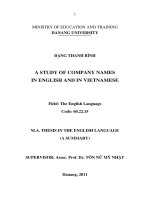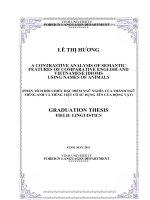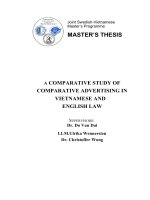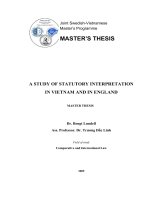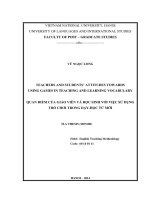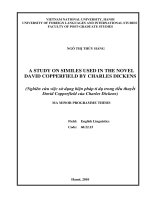A study of using dictionaries in learning and teaching at Lam Son high school for the fifted, Thanh Hoa = Nghiên cứu việc sử dụng từ điển trong dạy và học tiếng
Bạn đang xem bản rút gọn của tài liệu. Xem và tải ngay bản đầy đủ của tài liệu tại đây (549.9 KB, 59 trang )
VIETNAM NATIONAL UNIVERSITY, HANOI
UNIVERSITY OF LANGUAGES AND INTERNATIONAL STUDIES
FACULTY OF POST-GRADUATE STUDIES
*********************
NGUYỄN THỊ THANH HỒNG
A STUDY OF USING DICTIONARIES IN LEARNING AND TEACHING
AT LAM SƠN HIGH SCHOOL FOR THE GIFTED, THANH HOA
NGHIÊN CỨU VIỆC SỬ DỤNG TỪ ĐIỂN TRONG DẠY VÀ HỌC TIẾNG
ANH TẠI TRƢỜNG THPT CHUYÊN LAM SƠN, THANH HÓA
M.A MINOR PROGRAMME THESIS
FIELD: ENGLISH TEACHING METHODOLOGY
CODE: 60140111
Hanoi, 2014
VIETNAM NATIONAL UNIVERSITY, HANOI
UNIVERSITY OF LANGUAGES AND INTERNATIONAL STUDIES
FACULTY OF POST-GRADUATE STUDIES
*********************
NGUYỄN THỊ THANH HỒNG
A STUDY OF USING DICTIONARIES IN LEARNING AND TEACHING
AT LAM SƠN HIGH SCHOOL FOR THE GIFTED, THANH HOA
NGHIÊN CỨU VIỆC SỬ DỤNG TỪ ĐIỂN TRONG DẠY VÀ HỌC TIẾNG
ANH TẠI TRƢỜNG THPT CHUYÊN LAM SƠN, THANH HÓA
M.A MINOR PROGRAMME THESIS
FIELD: ENGLISH TEACHING METHODOLOGY
CODE: 60140111
SUPERVISOR: Dr. NGÔ HỮU HOÀNG
Hanoi, 2014
i
DECLARATION
This thesis is submitted in partial fulfillment of the requirements for the degree of
Master of Education. I certify that the thesis is the report of my own research, and
that it has not been submitted for any other university or institution.
Thanh Hoa, September, 2014
Student‘s signature
Nguyễn Thị Thanh Hồng
ii
ACKNOWLEDGEMENTS
First and foremost, I would like to express my gratitude to Dr. Ngô Hữu
Hoàng - my supervisor for his invaluable advice, constructive criticism, precious
correction and helpful encouragement in the completion of my minor thesis.
My thanks also go to all of the lecturers and the staff of the Department of
Post-Graduate Studies at University of Languages and International Studies,
Vietnam National University, Hanoi for their valuable lectures and supports.
I am also thankful to all the English teachers and students at Lam Son gifted
high school for answering the questionnaires and interviews, which are
indispensable for the analysis and discussion in my study.
Last but not least, I greatly appreciate the support and encouragement from
my family and friends.
Thanh Hoa, September 2014
iii
ABSTRACT
Focusing on using dictionaries in learning and teaching English at Lam Son
high school for the gifted, this action research is aimed at investigating the actual
using of dictionaries in learning and teaching English to find out the appropriate
way to use dictionaries. After carrying out preliminary investigation and literature
review, it is found out that most of the respondents had not been trained to use
dictionaries, and that they had difficulties in using it for reading comprehension. In
an attempt to examine the best way to teach students at Lam Son high school for the
gifted to use dictionaries in learning English, the study focuses on issues (1) in what
way do students at Lam Son high school for the gifted use dictionaries to enhance
learning English? (2) What are appropriate ways to teach students to use
dictionaries in learning English? The action research was then designed and
implemented in the second semester of the school year 2013-2014 with the
participation of 80 students from 10A and 11A. The data was collected by a number
of instruments including questionnaire for students, teacher‘s observation, and pre –
test and post – test. The result of the study indicates that most of the students had
not been trained to use dictionaries. They are too dependent on dictionaries.
Pedagogical recommendations are made to guide students to use the dictionary
effectively. The study will contribute to practice in using monolingual dictionaries
properly, help the learners and teacher in choosing the useful and suitable
dictionaries in general secondary schools as well as private Lam Son school for
the gifted.
iv
LIST OF TABLES
Table 1: Kinds of dictionaries are students using mostly
Table 2: Students „rating of their using dictionaries
Table 3: Frequency of using dictionaries
Table 4: Role of using dictionaries in learning English
Table 5: Purposes of using dictionaries
Table 6: Difficulties of using dictionaries
Table 7: Reasons for difficulties of using dictionaries
Table 8: Needs of training in using the dictionary
Table 9: Advantages of using monolingual dictionaries
Table 10: Students‟ result in the pre-test examination
Table 11: Students‟ result in the post-test examination
v
TABLE OF CONTENTS
DECLARATION i
ACKNOWLEDGEMENTS ii
ABSTRACT iii
LIST OF TABLES iv
TABLE OF CONTENTS v
PART A: INTRODUCTION 1
CHAPTER 1: INTRODUCTION 1
1. Rationale of the study 1
2. Aims of the study 2
3. Research questions 2
4. Scope of the study 2
5. Design of the study 3
6. Design of the study 3
PART B: DEVELOPMENT 5
CHAPTER 1: LITERATURE REVIEW 5
1.1. The lexicography. 5
1.1.1 Definitions of lexicography 5
1.1.2. Disciplines of lexicography 5
1. 2. The dictionary 6
1.2.1 Definition of the dictionary 6
1.2.2. Types of dictionaries 6
1.2.3. Role of the dictionary in learning and teaching English 10
1.3. The using dictionaries 11
1.3.1. Using dictionaries in learning teaching method 11
1.3.2. Level of students in using dictionaries. 13
1.4 Previous studies into Dictionary use 14
CHAPTER 2: METHODOLOGY 17
2.1 Action research 17
vi
2.1.1. What is action research? 17
2.1.2. Rationale for the use of an action research 17
2.2. Context of the study 20
2.3. Participants 20
2.4. Data collection 21
2.4.1. Questionnaires 21
2.4.2. Teacher‘s observation 21
2.4.3. The pre – test and post test 21
2.5. The action research procedure 22
CHAPTER 3: DATA ANALYSIS, FINDINGS AND DISCUSSIONS 24
3.1. Presentation of the data 24
3.2. Analysis, interpretation of the data and discussion 33
PART C: CONCLUSION 38
1. Summary of the study 38
2. Pedagogical implications of the study 38
3. Limitations of the study 40
4. Suggestions for further studies 40
REFERENCES 41
APPENDICES I
1
PART A: INTRODUCTION
CHAPTER 1: INTRODUCTION
1. Rationale
Nowadays, when the world is being globalized, learning another language as
a second language becomes more necessary. A big question is: In addition to the
skills, which was taught and learned at high school like listening, speaking, reading
and writing, using of dictionaries play important role or not in teaching and learning
foreign languages in general, and as English in particular.
There are many opinions given, everyone is arguing about this issue. There are
methods think that, do not need a dictionary for language learning, just guess the
meaning of the word is to achieve the purpose of communication, and it is advised
to use the main dictionaries when learning a foreign language. Some people
condemn the excessive use dictionaries; and others encourage students to use the
dictionary. So, what is right, what is wrong?
Truly, the dictionary is regarded as a tool that everyone uses when we learn
English. But in many people‘s mind, the training of using languages hasn‘t been pay
attention. Until the present, many students at high schools don‘t know how to use
dictionaries effectively. However, if asked to explain the use process in detail, even
language teachers may not be able to answer satisfactorily.
There are some researches on using dictionaries in the world or in Vietnam.
However, research on using dictionaries in learning and teaching English at gifted
high school has not been done yet.
Currently, I am teaching English at Lam Son high school for the gifted. At
my school, students divided into 2 groups: group of major English students and
groups of non-major students in other classes. Because of such characteristics, we
need to use different dictionaries for different students (see Context of study in
chapter 2 for more details).
As an English teacher, I have dealt with many questions relating to using
dictionary which are raised by my students or among my colleagues. For example,
2
what are the effective ways of using dictionary? How can use dictionary to enhance
learning? Personally I found it necessary to provide to them successful learning
strategies to learn English. This is the major reason why this topic interests me.
Therefore, I decide to carry out the topic: A study of using dictionaries in
teaching and learning English at Lam Son high school for the gifted. The author
hopes that the thesis would bring concrete benefits to teachers, students and so on.
2. Aims of the study
The study is ultimately aimed at investigating the actual using of dictionaries
in learning and teaching English and finding the difficulties when students use the
dictionary.
In addition, this study not only points out the appropriate ways to help
students use dictionaries effectively, but also contributes to the use of monolingual
dictionaries at school; prevent overuse of the dictionary.
Hopefully, the study will help learners and teachers in choosing the useful
and suitable dictionaries in general secondary schools as well as private Lam Son
high school for the gifted.
3. Research questions
The study sets out to seek answers to the following research questions:
1. In what way do students at Lam Son high school for the gifted use dictionaries to
enhance learning English?
2. What are appropriate ways to teach students to use dictionaries in learning
English?
4. Scope of the study
This study was conducted in two classes 10A and 11A at Lam Sơn high
schools for the gifted. In this study, I only focused on investigating the usage of
dictionaries for English major students. Because there are many kinds of
dictionaries, such as: monolingual, bilingual, pocket dictionaries, online
3
dictionaries, specialized dictionaries, etc., so I just focused on the usage of
monolingual and bilingual dictionaries.
5. Methods of the study
This study is conducted in the form of an action research. The data serving
the research analysis and discussion were collected by means of:
- Questionnaires for students
- Classroom observation
- Pre-test and Post-test
In addition, to make the data collected more reliable an authentic, qualitative
method was applied.
6. Design of the study
The study is divided into three parts.
Part A: Introduction shows the rationale for the research, the aims, the research
questions, the scope, the methods and the design of the study.
Part B: Development consists of three chapters.
Chapter 1: Literature review not only deals with an overview of background to
the study, including key concepts and theories to the research topic but also
discusses previous studies of the field to reveal the research gap which needs filling.
Chapter 2: Methodology introduces the participants, instrumentation, research
process and plan of action.
Chapter 3: Results and discussion
This chapter gives a detailed presentation of data and a detailed description
of data analysis. Some explanations and interpretations of the findings of the study
are also presented.
4
Part C: Conclusion.
This part contains some conclusions and some suggestions for using
dictionaries.
In addition, part C also gives some limitations of the study as well as
suggestions for further research.
References
Data sources
Appendixes
5
PART B: DEVELOPMENT
CHAPTER 1: LITERATURE REVIEW
This chapter is to set the present study against the research background of
lexicography and the dictionary, different kinds of dictionaries, role of the
dictionary and using dictionaries in learning and teaching English, levels of
students and some researches into dictionary use.
1.1. The lexicography
1.1.1 Definition of lexicography
Lexicography is the art of building, editing, and writing dictionaries. It may
be used in reference to the design and even evaluation of dictionaries. There are
even dictionaries that may be used for specific fields or subjects. Many dictionaries
are now digitized and computers have the ability to track and maintain entries much
better than using paper, pens, and human recollection.
1.1.2 Disciplines of lexicography
Lexicography is divided into two related disciplines:
Practical lexicography is the art or craft of compiling, writing and
editing dictionaries.
Theoretical lexicography is the scholarly discipline of analyzing and describing
the semantic, syntagmatic and paradigmatic relationships within
the lexicon (vocabulary) of a language, developing theories of dictionary
components and structures linking the data in dictionaries, the needs for
information by users in specific types of situation, and how users may best access
the data incorporated in printed and electronic dictionaries. Sometimes this is
referred to as met lexicography.
Lexicography is often described as the art of making, designing and
compiling dictionaries. The work of lexicographers includes compiling a stock of
words in a language and providing a description of each of them.
6
1.2. The dictionary
1.2.1 Definition of the dictionary
According to Wikipedia, a dictionary is collection of work in one or more
specific languages, often listed alphabetically (or by radical and
stroke for ideographic languages), with usage information, definitions, etymologies,
phonetics, pronunciation and other information or a book of words in one language
with their equivalents in another, also known as a lexicon.
According to Nielsen (2008), a dictionary may be regarded as a
lexicographical product that is characterized by three significant features: (1) it has
been prepared for one or more functions; (2) it contains data that have been selected
for the purpose of fulfilling those functions; and (3) its lexicographic structures link
and establish relationships between the data so that they can meet the needs of users
and fulfill the functions of the dictionary.
Dictionary is considered to be an effective tool for helping learn vocabulary
in a second or a foreign language. A good dictionary must have certain
characteristics mentioned in Crystal (1987) such as having paper quality, good
binding, containing encyclopedic information, clear definitions, giving guidance to
usage, being easily accessible, and having idioms, synonyms, antonyms, etc.
Furthermore, the dictionary is an important pedagogical tool that plays a vital
role in various processes of language learning including reading comprehension and
vocabulary learning and acquisition. But which kind of a dictionary students should
use has become a controversial issue in the literature. Should the dictionary use be
determined by students‘ level or proficiency or other factors?
1.2.2. Types of Dictionaries
Dictionaries can be classified by many criteria. One way of categorizing
dictionaries is by the number of languages contained in a dictionary. Nation (2001:
288-290) put dictionaries into three classes: monolingual, bilingual, and
bilingualized (although trilingual and multilingual dictionaries exist as well).
7
Monolingual dictionaries are written in only one language (e.g. English-English
learners dictionary) while bilingual dictionaries are written in two languages (e.g.
English-Vietnamese and Vietnamese-English dictionaries). Bilingualized
dictionaries contain monolingual L2 definitions immediately followed by an L1
translation or a L1 gloss (Pujol et al, 2006). This description applies when looking
up words in L2. When looking up words in L1, however, bilingualized dictionaries
just provide the translation, plus production information.
Dictionaries (monolingual, bilingual, bilingualized) can take many modes of
presentation. Nesi (1998) classifies dictionaries into two modes of presentation:
paper-based dictionaries and computer-based dictionaries (also known as electronic
dictionaries).
There are three types of electronic dictionaries: hand-held electronic
dictionaries (also known as pocket electronic dictionaries or PEDs), dictionaries on
CD-ROM, and dictionaries on the Internet. The main difference between electronic
dictionaries and paper-based dictionaries is not their information content but their
retrieval system (Nesi, 2000). The way a paper-based dictionary organizes
information is primarily linear, which is appropriate for the listing of a succession
of separate entries, while an electronic dictionary organizes in-formation so that
users can group or regroup words according to their semantic and pragmatic
similarities, their valence and collocation patterning, or their letter combinations. It
should be noted that Nesi refers to dictionaries on CD-ROM. Many PEDs and
dictionaries on the Internet, however, cannot yet function in this way. Most
dictionaries on CD-ROM and some PEDs do not only offer entries, but also audio
and visual elements, exercises and games. The huge amount of information that is
thus avail-able makes such a dictionary a novel reference tool. If an electronic
dictionary were to be fully developed, it would serve not only as a reference but
also as a language learning tool, and this to a much greater ex-tent than dictionaries
in paper-based form would ever be able to do. The types of dictionaries and the
modes that are relevant to this study are shown in Figure 1.
8
Figure 1 explains the focus of this study. A dictionary, which is a kind of
reference work, can be monolingual, bilingual, bilingualized, or multilingual, and
can be in either printed or electronic form. A dictionary on the Internet, a dictionary
on CD-ROM, and a pocket electronic dictionary (PED) are the focus of this study.
Figure 1: Lexicography and its branches
The study mainly focuses on two kinds of dictionaries when learning
languages: monolingual and bilingual dictionaries. A monolingual dictionary
explains the meaning of a word in the language that you are learning. A bilingual
dictionary provides a translation or explanation using another language, a language
you are very familiar with, usually your native language.
English monolingual dictionaries are created by English and American
scholars. Famous examples of such dictionaries are Oxford, Longman and Merriam-
Webster. Using them is difficult in my experience. Often I read the definition of the
word and am not sure if I correctly understand the meaning of the word. Maybe my
English is not advanced enough to use it. Reading the definition of the word takes
more time and requires more thinking to understand the meaning. The scope of a
monolingual dictionary is limited while listening or reading English texts. They are
useless when you want to write something yourself, such as this post, and you lack
the words you‘re looking for.
9
There are no such problems with bilingual dictionaries. The solution to the
problem is that the word‘s meaning appears instantly. So, many people use bilingual
dictionaries while learning English. However, the advantage of monolingual
dictionaries is that using them allows you to ―immerse‖ yourself so much more into
the language. In using such dictionaries, you can sometimes forget about your
native language and only think in your target language. Hayati & Fattahzadeh,
(2006) also claims that a monolingual dictionary not only demonstrates definitions
but also other important aspects. He believes that more encouragement should be
given to the use of monolingual dictionary because it promotes fluency by offering
definitions in context; in contrast the bilingual dictionaries tend to encourage word
for word translation equivalents that may not be appropriate in certain situations and
might cause confusion and ambiguity. Moreover, Bensoussan et al. (1984, as cited
in Hayati, 2006, p. 126) point out that the bilingual dictionaries seem to give
students security of concrete answers, while monolingual dictionaries often force
students to guess and predict the meaning, and lead to doubt and confusion.
Furthermore, monolingual dictionaries are likely to give a long and confusing
description that might not suggest the intended and desired meaning. However,
according to Bejoint (1981); quoted in Scholfield, (1982) ―those learners who use
monolingual dictionaries would help them to get into habit of thinking in the target
language‖ Scholfield, (1982, p. 22).
Further, Wingate (2002) as cited in Lew; (2004, p. 4) argue that monolingual
dictionaries have more limitations such as the definitions may be too difficult to
understand, learners may pass over important information such as semantic
restrictions of words, because they are not able to understand the basis of words
and the grammatical structure can be complex. In addition, according to Wingate
(2002; p. 24 as cited in Lew, 2004, p. 9) bilingual dictionaries have some
deficiencies such as reinforcing the learners‘ tendency to translate from native
language and, by encouraging translation; they discourage learners from thinking
directly in the foreign language. In addition, they claim these dictionaries do not
10
help learners to develop their academic skills such as paraphrasing, and they give
little information about semantically related words such as sense relations
(synonyms, antonyms, heteronyms, etc.). However most of the EFL learners prefer
the bilingual dictionaries because they are time-saving, straightforward and easy to
use.
The most obvious challenge for EFL learners is the language of monolingual
dictionaries, as they contain definitions, symbols and other morphological
information about the words which are difficult for less proficient students to
understand. However, the language in bilingual dictionaries is very straightforward
and contains less definitions and morphological information which would
encourage EFL learners to choose them.
1.2.3. Role of dictionaries in learning and teaching English
In his book, Thornbury (2002) mentions that knowing a word includes
knowing its written and spoken form, its meanings and the words it is most
commonly associated with, its derivation, how it is used in different situations, its
frequency, its grammatical behavior, its connotations, and how it can be used as a
verb, noun, adverb, etc. Learners can individually find all this information in a well-
chosen dictionary. Using a dictionary will also help the learner develop
autonomy: “A learner who makes good use of a dictionary will be able to continue
learning outside the classroom, and this will give him considerable autonomy about
the decisions he makes about his own learning.” (Gairns & Redman, 2005:79). It
also gives the learner good learning habits: “There is tremendous amount of
information in a good learner‟s dictionary – sometimes an overwhelming amount.
Helping students tap into that information efficiently is one of the best ways to help
them become independent, lifelong language learners.” (Leaney, 2007:1)
We can see that dictionaries are very important language learning tool. They
are as useful as they can be counter-productive. To make dictionaries useful,
students must understand the role of dictionaries in English vocabulary building.
11
The following points listed below are some of the general reasons why we
should use dictionaries:
In some cases of ESL/EFL teaching, words could be specific to a certain
profession. Sometimes looking up professional jargons is unavoidable.
There are situations where the vocabulary of a lesson can be new to students,
even in their own native language.
Sometimes we are unsure of the spelling of some words. Of course
dictionaries are very useful at such times.
Idiomatic expressions and phrasal verbs can sometimes be too difficult to
guess, thereby necessitating the use of dictionaries.
Some classroom activities and the teaching of certain skills are planned
around a dictionary.
A dictionary can be a student‘s study companion at home or away when the
teacher is not around. Even then, the issue of when to use it is also very important.
There are many ways of understanding the meanings of new words and
expressions without using the dictionary. Despite the importance of dictionaries in
ESL/EFL learning, they should be used as the last resort especially in the
classrooms. So what is the problem with using a dictionary often?
Truly, a dictionary is of great help to everyone especially to students who are
learning a language. It is also helpful in enriching our vocabulary. So, to help
learners fully understand a word and thus develop their vocabulary, to help they are
more autonomous and to enhance good learner habits, as language teachers, we
should all be aware of the importance of using a dictionary in language learning.
We should guide our students to choose a good dictionary and encourage them to
refer to it frequently.
1.3. Using dictionaries
1.3.1. Using dictionaries in English teaching methods
There are many methods that are usually used by teachers to teach the
foreign language. Such as: grammar – translation method, direct method,
12
Communicative approach, etc. Every method has individual characteristics.
Therefore, using dictionary of student and teachers in each method is equal.
Firstly, the Grammar-Translation Method focuses on developing students'
appreciation of the target language's literature as well a teaching the language.
Students are presented with target-language reading passages and answer questions
that follow. Other activities include translating literary passages from one language
into the other, memorizing grammar rules, and memorizing native-language
equivalents of target language vocabulary. Class work is highly structured, with the
teacher controlling all activities. Objectives of Grammar-translation method is to be
able to read literature written in the target language. It‘s also to be able to translate
from one language to another and to develop reading and writing skill. So, students
often must use dictionary.
Secondly, the Direct Method allows students to perceive meaning directly
through the language because no translation is allowed. Visual aids and pantomime
are used to clarify the meaning of vocabulary items and concepts. Students speak a
great deal in the target language and communicate as if in real situations. Reading
and writing are taught from the beginning, though speaking and listening skills are
emphasized. Grammar is learned inductively. It is a natural method. It teaches the
second/foreign language in the same way as one learns one‘s mother tongue. The
language is taught through demonstration and conversation in context. Pupils,
therefore, acquire fluency in speech. They are quick at understanding spoken
English. They can converse in English with felicity and ease. There is no gap
between active and passive vocabulary. This method does not differentiate between
active and passive vocabularies. According to this method whatever is required for
understanding through English is also required for expressing through it. If English
is taught through the mother tongue, the gulf between the active and passive
vocabularies is widened. The learner acquires more of passive vocabulary because
he concentrates on understanding English rather than expressing through it.
Therefore, in this method, student rarely use dictionary.
13
What about the communicative approach? The Communicative Approach
stresses the need to teach communicative competence as opposed to linguistic
competence; thus, functions are emphasized over forms. Students usually work with
authentic materials in small groups on communicative activities, during which they
receive practice in negotiating meaning. Communicative language teaching makes
use of real-life situations that necessitate communication. The teacher sets up a
situation that students are likely to encounter in real life. Unlike the audio-lingual
method of language teaching, which relies on repetition and drills, the
communicative approach can leave students in suspense as to the outcome of a class
exercise, which will vary according to their reactions and responses. So, in this
method using dictionary is somehow important.
1.3.2. Level of students in using dictionaries
The dictionary is very useful in learning English. However, correct
dictionary usage should be taught and encouraged. It becomes a useful tool to better
acquire and apply new language.
First and foremost, bilingual dictionaries work best with low-level students.
Upper-level students should restrict usage to monolingual dictionaries. Intermediate
students may use a combination of both. At low-level, students don‘t possess the
vocabulary to successfully negotiate all the words in a definition. If they must check
additional words just to understand the initial definition, then this steals valuable
classroom time. They‘re also moving away from the focus of the lesson, so there‘s
less of a chance to use the new, incidental words. Plus there‘s so much information
that retention worsens.
As a final comment, beginners may also be intimidated by dictionaries, so a
bilingual one is quick and easy to understand. They can quickly return to the task at
hand. At intermediate levels, sole use of a bilingual dictionary encourages
translation. What‘s more, the dictionary lacks any culture references or nuance, as it
provides only a list of words. Of the word listed, some may be uncommon or appear
only in print. Others may be old-fashioned or not be appropriate to the situation.
14
Unfortunately, intermediate students lack the vocabulary depth needed to solely use
an English-English dictionary. As such, they may get stuck with the words in a
monolingual dictionary. Like beginners, they may have to look up several words to
understand the initial definition. In addition, they may just barely understand the
word, which mean they‘re likely to use it.
For intermediate students, a combination of monolingual and bilingual
dictionaries works best. Students may first refer to one dictionary, check the other
and then return to the initial dictionary. This back and forth reinforces
comprehension. It also increases the chances that students will use the word.
Advanced students should be fully capable of consulting a monolingual dictionary.
There‘s no loss of meaning through translation. Students can also check which
word/definition is most appropriate to the situation. What‘s more, the students can
continue to think and word in the L2. Monolingual dictionaries can be tedious.
Advance students more actively work towards understanding through context
because it‘s often quicker that checking a dictionary. At this level, they have
sufficient skills and strategies which allow them to work around unknown words.
Whatever the level of student, limited and appropriate dictionary use proves
keys. Students should understand, and if necessary be reminded, that the purpose of
the activity is communication, or listening, or stringing together thoughts into a
single narrative, just to name a few possible examples. This can all be accomplished
without constantly checking the dictionary.
1.4. Previous studies into dictionary use
Language learners‘ use of the dictionary has been studied from various
perspectives. For example, studies have focused on the accuracy of learners‘
dictionary use (Nesi 2002; Gonzales 1999; as cited in Pousi; 2010), the effect of the
dictionary use on vocabulary learning and reading comprehension; (Knight ,1994),
and on the effect of different types of dictionaries such as bilingual, monolingual
and bilingualized dictionaries (Laufer and Hadar 1997; Tomaszczyk 1979).
Tomaszczyk (1979) was the pioneer and the first researcher to initiate an
15
investigation into the dictionary use by non-native speakers of English.
(Tomaszczyk, 1979, as cited in Ryu, 2005) he conducted a study based on Polish
learners at the university level for foreign language instructors, and translators.
Although participants expressed their satisfaction with monolingual dictionaries, the
majority preferred to use bilingual dictionaries over monolingual dictionaries. But
the current study is focused on EFL foundation students not students who are
majoring in English language as in the above mentioned study.
A similar study was conducted by Bejoint (1981) on French EFL students‘
use of monolingual English dictionaries. The results reveal that only 17% of the
participants preferred the bilingual dictionary in contrast to Tomaszczyk‘s study.
Moreover, recent studies focus on dictionary use training (Atkins and Varantola,
1998; Li, 1998; Hartmann, 1999; and Sanchez, 2005) as cited in Ryu; (2005) in all
these studies the majority of the students indicates that they never received
dictionary use training. However, a study by Laufer and Hadar (1997) cited in
Pousi, (2010, p. 6) on pre-advanced and advanced learners reveals that the unskilled
dictionary users performed better in comprehension and production when using a
bilingual dictionary, as opposed to using a monolingual one. Moreover, Loucky,
(2001) conducted a study on Japanese learner and the use of dictionary and it was
found out that the majority of Japanese learners prefer bilingual dictionaries
particularly the computerized ones. In addition, a similar study was conducted by
Schmidt (1997) as cited in Pousi (2010) to survey Japanese EFL learners‘
perceptions about the use of bilingual and monolingual dictionaries, and the results
indicated that (85%) of the respondents report that they prefer to use bilingual
dictionaries and only (15%) preferred to use monolingual dictionaries.
In addition, a study was conducted by Hayati (2005) to investigate the impact
of the bilingual dictionary compared with the monolingual on reading
comprehension among EFL Iranian intermediate students studying at Shahid
Chamran University of Ahwaz. The results indicated that using a dictionary during
reading can aid intermediate students to comprehend a text more efficiently.
16
Regarding the effectiveness of the bilingual dictionary, the results reveal that the
bilingual dictionary is a powerful and effective pedagogical tool; it can appear as
useful as a monolingual one in reading comprehension of intermediate EFL
students. In light of the results above, both dictionaries are important, and bilingual
dictionaries are the best for beginners and intermediate-level learners and
monolingual dictionaries for the advanced-level ones.
Therefore, this study is set out to explore the students‘ attitudes and
perceptions about the use of the dictionary in general, and the monolingual and
bilingual in particular in both classroom and during exams with special emphasis in
EFL context specifically at Lam Son gifted high school, Thanh Hoa.
17
CHAPTER 2: METHODOLOGY
With an attempt to make the study valuable and reliable, I use an action research
method. This method includes the following instruments:
- Questionnaires
- Pre-test and Post-test
- Classroom observation
2.1. Action research
2.1.1. What is an action research?
Corey (1953) defines action research as ―a way in which teachers try to study
their own problems scientifically, in an effort to evaluate, guide and correct their
procedures‖. Looking at the effectiveness of action research, Tsui (1993) states that:
―Action research is a very effective way of helping teachers to reflect on their
teaching and to come up with their own alternatives to improve their practice‖
(Tsui, 1993, p.33).
Grebhard and Oprandy (1999) define action research at two levels, the inside
classroom level and the outside classroom level: ― At one level, action research is
about teachers identifying and posing problems, as well as addressing issues and
concerns related to the problem. It is about working toward understanding and
possibly resolving these problems by setting goals and creating and initiating a plan
of action, as well as reflecting on the degree to which the plan work. At another
level, it can be about addressing adduction practices that go beyond each teacher‘s
classroom (p.12).
2.1.2. Rationale for the use of an action research
As defined by Milss (2003:4), an action research is ―any systematic inquiry
conducted by teacher researchers to gather information about the ways that their
particular school operates how they teach, and how well their students learn. The
information is gathered with the goals of gaining insight, developing reflective
practice, effecting positive changes in the school environment and on educational
practice in generals, and improving student outcomes‖. Kemmis and Mc Taggart


